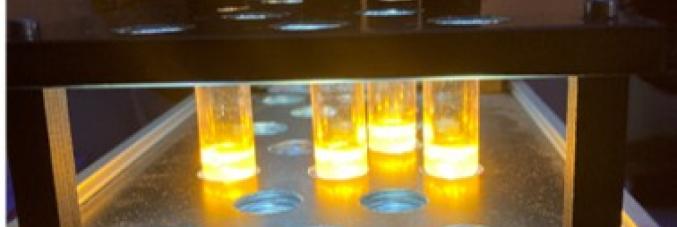
Unipd studies new methods to produce hydrogen or hydrogen peroxide
10.06.2025
Hydrogen is considered one of the most promising energy carriers for the future: it is clean, as it burns producing only water, and it is highly efficient, generating four times more energy than oil per unit of mass. Besides its strategic role in the energy transition, hydrogen is also a crucial raw material for the chemical and petrochemical industries, where it is used in up to 70% of production processes, for example, for the synthesis of hydrogen peroxide, which is present in millions of tonnes every year in our homes, healthcare services, and supermarkets.
Currently, however, hydrogen and hydrogen peroxide are produced through energy-intensive industrial processes that heavily rely on fossil fuels. Therefore, using sunlight to obtain these molecules—drawing inspiration from natural photosynthesis—is a highly significant scientific challenge. This approach is based on photocatalysis, a process where a substance absorbs light and uses the gathered energy to trigger useful chemical reactions. Simply put, it is a way to transform light into chemical energy, for example, to obtain hydrogen from water or hydrogen peroxide from the oxygen in the air. There are already photocatalytic materials capable of promoting one of these two processes individually, but designing a system capable of modulating the final product—selectively switching from hydrogen to hydrogen peroxide—by merely changing the conditions remains an open challenge.
With this objective, a research team from the Department of Chemical Sciences at the University of Padua has designed an innovative organic molecule that can “intelligently” respond to environmental conditions, transforming into different nanostructures that activate two distinct photocatalytic processes: the production of hydrogen or hydrogen peroxide, simply by modifying the way the molecules aggregate.
This research, recently published in the journal «Advanced Functional Materials», was conducted by PhD student Marianna Barbieri and coordinated by Professor Luka Ðorđević. The study demonstrates how a single dye-based molecule can self-assemble into two different nanostructures with completely different behaviours.
«The fibrous nanostructures generate hydrogen from water under sunlight, while the particulate nanostructures activate the production of hydrogen peroxide from air and light. To achieve this bifunctional behaviour, we exploited the principles of supramolecular chemistry, which allows precise control over how organic molecules, in this case a dye, organize themselves in space and communicate with each other. This control over self-assembly proved crucial for modulating photocatalytic activity», says Marianna Barbieri. «Another crucial aspect is sustainability: the developed materials are entirely organic, contain no rare metals, and are recyclable and reusable, thus contributing to greener, safer, and more economical chemistry. This work confirms how fundamental research, combined with an interdisciplinary vision, can give rise to advanced technologies with real impact on society and the environment».



